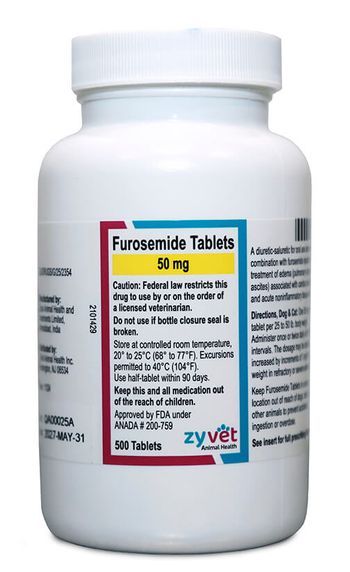
Therapy of new onset and refractory heart failure (Proceedings)
Diuretics (reduction in preload), vasodilators (reduction in preload or afterload), angiotensin converting-enzyme inhibitors (reduce afterload and preload, reduce fibrosis), and positive inotropic drugs (increase contractility, may reduce regurgitant volume) all have demonstrated the capacity to lessen the severity of mitral regurgitation and dilated cardiomyopathy under certain conditions.
Diuretics (reduction in preload), vasodilators (reduction in preload or afterload), angiotensin converting-enzyme inhibitors (reduce afterload and preload, reduce fibrosis), and positive inotropic drugs (increase contractility, may reduce regurgitant volume) all have demonstrated the capacity to lessen the severity of mitral regurgitation and dilated cardiomyopathy under certain conditions. The relative merits of specific agents vary with the clinical circumstances of each patient. All therapeutic recommendations should be based on a complete cardiovascular evaluation to identify the specific requirements of each dog. The current standard of therapy for dogs with chronic congestive heart failure is combination therapy using diuretics, angiotensin converting enzyme inhibitors and positive inotropic agents. Dogs requiring medical therapy to control the signs of heart failure should avoid strenuous exercise although the potential benefits of sub-maximal exercise for cardiac rehabilitation are unknown. Increasingly severe exercise restriction should be enforced as the disease progresses. Some cardiologists promote low sodium diets although their benefits have not been proven by large, placebo-controlled studies to date. The prognosis varies with the stage of the disease and it is currently impossible to predict the rate of progression for an individual patient. Some factors that adversely affect the prognosis are:
• Poor response to therapy
• The concurrent presence of renal failure (and other systemic diseases)
• The presence of complicating sequela such as ruptured chordae tendineae, left atrial tears, and atrial fibrillation
Diuretics
Loop diuretics-furosemide
Loop diuretics inhibit the Na/K/2Cl co-transporter in the ascending loop of Henle, causing obligatory loss of sodium and water into the urine. The oral absorption of furosemide is only 60 to 70% in healthy dogs and probably less in animals with heart failure. Furosemide is used to help control excessive plasma volume that ultimately contributes to the development of congestive heart failure while failing to augment cardiac contractility (plateau of the Frank-Starling curve). Diuretics are the most effective drugs available for the symptomatic short-term treatment of congestive heart failure in animals. They are administered to reduce blood volume and, thereby, to lower filling pressures and alleviate congestion and associated clinical signs. With judicious use of diuretics, indirect improvement in cardiac output may result from improved oxygenation as pulmonary function returns towards normal. Diuretics tend to decrease preload and can aggravate low cardiac output signs if used overzealously. Always use the lowest dose necessary to control signs.
Furosemide is approved for use in dogs, cats, and horses, and it has a very wide margin of safety. Rarely, it causes serious electrolyte imbalances. An occasional patient may develop hypokalemia, hyponatremia and hypochloremia (hypochloremic alkalosis), requiring temporary withdrawal of the drug or reduction in dosage. Excessive use can lead to dehydration, renal failure, low cardiac output, and circulatory collapse. These problems are most likely when high doses of furosemide are used with an angiotensin converting enzyme inhibitor, like enalapril. It appears that diuretics (all classes) activate systemic compensatory mechanisms, including the renin-angiotensin-aldosterone system and sympathetic nervous system. Thus, while these agents are the most effective drugs used in the short-term management of congestive heart failure, they have inherent limitations.
Angiotensin converting enzyme inhibitors: Enalapril, Benazepril
The angiotensin-converting enzyme inhibitors are the most important class of neurohormonal antagonists currently available for treating congestive heart failure. Inhibition of this strategic enzyme results in decreased formation of the circulating angiotensin II and a concomitant decline in blood aldosterone concentrations. By these mechanisms ACE inhibiting drugs are believed to palliate the deleterious consequences of vasoconstriction and sodium retention in patients with heart failure. Some of the anticipated hemodynamic changes resulting from ACE inhibition include decreased atrial and ventricular filling pressures, decreased peripheral vascular resistance, and increased cardiac output. Because ACE also inactivates bradykinin, tissue accumulation of this substance may contribute to the observed hemodynamic and cardiovascular effects of ACE inhibiting drugs. Bradykinin induces vasodilation directly and indirectly by increasing production of the prostaglandins, PGI2 and PGE2. Local or tissue renin-angiotensin systems have been demonstrated in a number of different organs, such as the kidney, brain, heart, blood vessels, and adrenal glands. These local renin-angiotensin systems are believed to regulate cellular growth. They may also play an important role in the development of the vascular changes and ventricular remodeling processes observed in patients with heart disease. Inhibition of ventricular remodeling might protect against the adverse consequences of myocardial fibrosis and the deterioration of left ventricular function, thereby offering an alternate explanation for increased survival in patients treated with ACE inhibitors.
Overall, ACE inhibitors appear to be safe and well tolerated in dogs with congestive heart failure. The majority of adverse reactions observed in controlled clinical trials of enalapril were mild and similar to those observed in dogs receiving placebo. Preliminary studies suggest that the adverse effects of lisinopril are similar to those observed with enalapril. Insufficient numbers of dogs have been treated with lisinopril to comment on the relative prevalence or severity of these adverse reactions. Some of the specific adverse effects of ACE inhibiting drugs include systemic hypotension, hyperkalemia, and renal dysfunction. When appropriate dosages are adhered to, systemic hypotension is an infrequently observed complication of ACE inhibitor treatment in dogs. Furthermore, most dogs that experience a hypotensive reaction caused by the administration of an ACE inhibitor can be adequately managed by simply reducing the dose of the offending drug. Hyperkalemia is also occasionally observed in dogs receiving ACE-inhibiting drugs. Hyperkalemia appears to result from severely reduced glomerular filtration and diminished release of aldosterone from the adrenal gland (due to reduced levels of angiotensin II). The degree of hyperkalemia is usually mild and few dogs develop clinical signs of hyperkalemia. Severe hyperkalemia should prompt discontinuation or reduction in dosage of the ACE inhibitor. The problem of azotemia in dogs receiving ACE-inhibiting drugs is confusing and controversial. Evidence of mild to moderate renal dysfunction is common in a substantial percentage of dogs with congestive heart failure, regardless of the form of treatment selected. Azotemia is usually interpreted in this population of dogs as evidence of decreased renal perfusion (prerenal azotemia) combined with an age-related decline in renal functional capacity. Angiotensin converting enzyme inhibitors are known to decrease glomerular filtration pressure by virtue of their vasodilating effects on the renal efferent arterioles. As a result, treatment with an ACE inhibitor can and often does result in mild azotemia and slightly increased serum creatinine concentrations. In most dogs treated with an ACE inhibitor renal function soon normalizes or stabilizes at a new steady state. In some circumstances, severe renal failure is observed shortly after initiating ACE inhibitor therapy. This consequence may be more common in dogs with serious preexisting renal disease, in dogs that are dehydrated, and in dogs experiencing systemic hypotension. It is prudent to evaluate renal function prior to and about 5 to 7 days after initiating an ACE-inhibiting drug. Most dogs that display intolerance can be adequately managed by decreasing either the dose of the ACE inhibitor or diuretic. On rare occasion, ACE inhibitor therapy may have to be abandoned.
Positive inotropes
Calcium sensitizers/PDE inhibitors-Pimobendan
Calcium sensitizers have the ability to augment systolic performance by enhancing calcium-binding to troponin C or by affecting the cross-bridge turnover kinetics without increasing cytosolic calcium levels. A potential drawback to the clinical application of pure calcium sensitizers would be impairment of myocardial relaxation secondary to the enhanced reactivity of troponin C with diastolic cytosolic calcium levels. Most of the agents under investigation today utilize a combination of phosphodiesterase (PDE) inhibition and calcium sensitization to avoid diastolic dysfunction. Because they display both calcium sensitization and PDE inhibition it becomes difficult to identify if the positive inotropic action stems from enhanced reactivity of troponin C and Ca2+ , cAMP-mediated phosphorylation of phosphoproteins, or a combination of the two. Early studies of pimobendan in dogs with heart failure secondary to mitral valve insufficiency and Dobermans with heart failure secondary to dilated cardiomyopathy have been promising.
Although pimobendan has not been studied as extensively as ACE inhibitors in the United States, use of this agent in dogs with congestive heart failure appears to be overall safe and well-tolerated. There is some theoretical concern that the PDE inhibiting component of pimobendan may carry the potential for cAMP-dependent increases in arrhythmogenesis and currently I use this drug cautiously in dogs with significant, uncontrolled ventricular ectopy. However pimobendan appears capable of increasing cardiac contractility to a similar degree as dobutamine but at a lower O2 cost which may limit the likelihood for pro-arrhythmia. Additional reported adverse effects include the development of ventricular concentric hypertrophy and worsening of the histologic grade of valve lesions in asymptomatic dogs with mitral valve disease in comparison to benazepril. The frequency of these adverse effects is uncertain.
Digitalis glycosides-Digoxin
The digitalis glycosides inhibit Na+/K+ ATPase at the membrane level such that more Na+ is made available for exchange with extracellular Ca++. As a result, more Ca++ is made available to the contractile elements, resulting in a positive inotropic effect. The digitalis glycosides increase the velocity and force of contraction of the normal and failing myocardium at any given level of preload, thus shifting the Frank-Starling curve upwards. Digitalis glycosides also slow conduction through the AV node by both direct and indirect vagal effects. As a result, the heart rate usually slows, particularly when supraventricular arrhythmias, such as atrial tachycardia or atrial fibrillation, are present. Digoxin may also partially restore baroreceptor reflexes that are blunted in patients with heart failure.
Digitalization is indicated in virtually every patient with congestive heart failure and a pathologic supraventricular tachycardia, e.g. atrial tachycardia, flutter or fibrillation. Digitalization may also be indicated in patients with congestive heart failure secondary to dilated cardiomyopathy that either 1) cannot afford or tolerate pimobendan or 2) remain in heart failure despite appropriate doses of pimobendan. Digitalization is not indicated in patients with pericardial disease or hypertrophic cardiomyopathy. Digitalization is of questionable benefit in patients with fixed outflow tract obstruction or cor pulmonale. Many fault the digitalis glycosides because of their potential toxic side affects and weak positive inotropic effects. With informed judicious use, toxic side effects can usually be avoided. Signs of digitalization include 1) slowing of the heart rate, 2) relief of clinical signs of heart failure, 3) increased PR interval duration (unreliable), and 4) demonstration of therapeutic blood levels.
Adverse and toxic effects of digitalis glycosides include: 1) Digoxin increases contractility resulting in increased myocardial oxygen consumption. This effect is offset by the decrease in heart rate and ventricular size (and thus wall tension) and increased coronary perfusion. 2) Toxic signs are frequently seen due to the narrow margin of safety. Clinical signs usually consist of anorexia, nausea, vomiting, diarrhea, depression and weakness. In addition, a variety of arrhythmias may be observed, some of which are quite dangerous. With oral administration, gastrointestinal signs almost always develop prior to arrhythmia. Some of the more common rhythm disturbances observed include first and second degree heart block, accelerated junctional rhythms, ventricular premature contractions, ventricular tachycardia and atrioventricular dissociation. 3) Digoxin binding at the membrane level is augmented by low K+ and high Na+ in the extracellular fluid. Thus, toxicity is augmented by these electrolyte disturbances. Treatment of digitalis toxicosis includes: 1) Stop digitalis and diuretic administration for 24 to 36 hours. Then re-institute, at lower dose. 2) Check electrolyte status; correct hypokalemia if present. 3) Life-threatening arrhythmias should be appropriately treated. 4) Specific antidote is available and consists of antibody fragments that scavenge the free drug from the body.
Diuretic synergism – management of refractory heart failure
While twice-daily administration of a loop diuretic appears to be the most frequently utilized regimen to manage congestive heart failure there are physiologic benefits to altering the dosing frequency, route of administration or combining agents from different classes. Furosemide is not a long-acting formulation. Therefore the diuretic effects of twice daily furosemide administration likely do not provide 24-hour diuresis. During the time when the Na+ /K+ /2Cl- pump is not inhibited it will avidly resorb sodium thereby negating some of the natriuretic effect. This highlights that three times daily dosing of furosemide may be more beneficial than merely increasing the twice-daily dose. In chronic, refractory cases of congestive heart failure, subcutaneous or intramuscular furosemide may be effective even if the animal is refractory to oral therapy. Alternatively, a combination of different types of diuretics can be used in this circumstance.
In addition to the ascending limb of the loop of Henle resorbing sodium the segments of the nephron distal to the loop of Henle are capable of contributing to the phenomenon of diuretic resistance. Increased sodium delivery to the distal nephron promotes hypertrophy and increased resorptive capacity of the early distal tubule, the connecting tubule and the cortical collecting duct. It appears aldosterone is the major mediator of this hypertrophic process. Strategies to combat diuretic resistance associated with long-standing loop diuretic administration can include: (1) addition of a thiazide diuretic to encourage diuresis within the hypertrophied region and/or (2) addition of an aldosterone antagonist to target the proposed hypertrophic mechanism. Utilizing multiple agents displaying activity within different regions of the nephron may help control congestive signs in patients that were refractory to furosemide administration alone. Despite the potential benefits a more aggressive diuretic protocol will predispose to the development of electrolyte abnormalities and a reduction in cardiac output and GFR. Outpatients should be carefully and periodically evaluated with biochemical profiles to ensure adverse effects are avoided.
Thiazide diuretics-Chlorothiazide, hydrochlorothiazide
The thiazides block reabsorption of Na+ in the distal convoluted tubule by inhibiting the Na+ /Cl- co-transporter. Compared to loop diuretics, the thiazides are relatively weak whereby they increase renal sodium excretion from a normal value of about 1% to 5% - 8% of the filtered load. Despite their relatively weak natriuretic effect they appear to promote a synergistic effect when administered with a loop diuretic. Although the combination of loop and thiazide diuretics appears effective at combating refractory pulmonary edema caution must be taken to avoid the development of hypokalemia. One strategy to prevent excessive potassium loss is to administer the thiazide every second or third day while continuing daily treatment with furosemide. The two most frequently utilized thiazide diuretics are chlorothiazide and hydrochlorothiazide. Both drugs display good oral absorption with a relatively rapid onset of action. Chlorothiazide (20 to 40 mg/kg PO BID) promotes diuresis within 1 hour, its activity peaks at 4 hours and its effect lasts 6 to 12 hours. Hydrochlorothiazide (2 to 4 mg/kg PO BID in dogs; 1 to 2 mg/kg PO BID in cats) has on onset of action within 2 hours, its activity peaks at 4 hours and its effect lasts 12 hours.
Potassium-sparing diuretics-Spironolactone
While potassium-sparing diuretics were once solely allocated to the late stages of heart failure or to patients with hypokalemia, they have recently come to the forefront in the battle against neurohormonally mediated progression of cardiac disease. Aldosterone promotes the production of Na+ /K+ exchangers along the luminal surface of the distal tubule and collecting ducts and it is now recognized to contribute to myocardial fibrosis, augmentation of sympathetic tone and possibly diuretic resistance. It has been postulated that the aldosterone antagonist (and potassium-sparing diuretic) spironolactone has the ability to inhibit myocardial fibrosis and promote mortality benefits. Spironolactone is well absorbed from the gastrointestinal tract but it has a relatively slow onset of action, peaking at 2 to 3 days after administration. It undergoes rapid hepatic metabolism to pharmacologically active canrenone. Spironolactone is administered to dogs at a dose of 1 to 2 mg/kg orally every 12 hours, in conjunction with an ACE inhibitor, a positive inotrope and a loop diuretic, to combat congestive heart failure.
Newsletter
From exam room tips to practice management insights, get trusted veterinary news delivered straight to your inbox—subscribe to dvm360.






